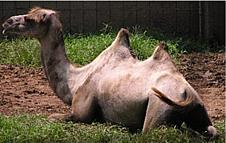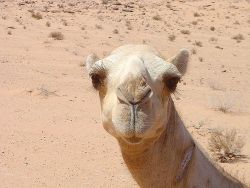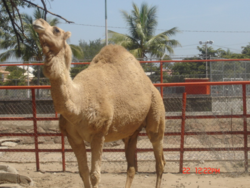Camel
2007 Schools Wikipedia Selection. Related subjects: Mammals
| iCamels | ||||||||||||
|---|---|---|---|---|---|---|---|---|---|---|---|---|
 Bactrian Camel, Camelus bactrianus  Dromedary, Camelus dromedarius
|
||||||||||||
| Scientific classification | ||||||||||||
|
||||||||||||
|
|
||||||||||||
|
Camelus bactrianus |
Camels are even-toed ungulates in the genus Camelus. The Dromedary or Arabian Camel has a single hump, and the Bactrian Camel has two humps. They are native to the dry and desert areas of Northern Africa and Asia, respectively. The average life expectancy of a camel is 30 to 50 years. The term camel is also used more broadly to describe any of the six camel-like creatures in the family Camelidae: the two true camels, and the four South American camelids: Llama, Alpaca, Guanaco, and Vicuña.
The name camel comes via the Greek κάμηλος (kámēlos) from the Arabic جمل (jamal) or the Hebrew גמל (gahmal), all meaning "camel".
Bactrian camels have two coats: the warm inner coat of down and a rough outer coat which is long and hairy. They shed their fiber in clumps consisting of both coats, which can be gathered and separated. They produce about 7 kg (15 lb) of fiber annually. The fibre structure is similar to cashmere wool. The down is usually 2 to 8 cm (1–3 inches) long. Camel down does not felt easily. The down is spun into yarn for knitting.
A fully-grown adult camel stands 1.85m/6 feet at the shoulder and 2.15m/7 feet at the hump. It can run up to 40mph in short bursts, and sustain speeds of up to 25mph.
Humans first domesticated camels between 3,500–3,000 years ago. The Dromedary and the Bactrian Camel are both still used for milk (which is more nutritious than cow's milk), meat, and as beasts of burden—the Dromedary in western Asia, and the Bactrian Camel further to the north and east in central Asia.
Distribution and numbers
Although there are almost 13 million Dromedaries alive today, the species is all but extinct in the wild, persisting mainly as domesticated animals (mostly in Sudan, Somalia, India and nearby countries), as well as South Africa, Namibia and Botswana. There is, however, a substantial feral population estimated at up to 700,000 in central parts of Australia, descended from individuals introduced as means of transport in the 19th century and early 20th century. This population is growing at approximately 11% per year and in recent times the state government of South Australia has decided to cull the animals using aerial marksmen, the reason being that the camels use too much of the limited resources needed by sheep farmers. For more information, see Australian feral camel.
The Bactrian Camel once had an enormous range, but is now reduced to an estimated 1.4 million animals, mostly domesticated. It is thought that there are about 1000 wild Bactrian Camels in the Gobi Desert, and small numbers in Iran, Afghanistan and Kazakhstan.
A small population of introduced camels, Dromedaries and Bactrians, survived in the Southwest United States until the 1900s. These animals, imported from Turkey, were part of the US Camel Corps experiment and used as draft animals in mines, and escaped or were released after the project fell through.
According Reuters, the recent discovery of a previously unknown giant camel species in central Syria, thought to be 100,000 years old, is leading scientists to reconsider traditional theories of camel origins.
Camel hybrids


Bactrian Camels have two humps and are rugged cold-climate camels while Dromedaries have one hump and are desert dwellers. Dromedary hybrids are called Bukhts, are larger than either parent, have a single hump and are good draft camels. The females can be mated back to a Bactrian to produce ¾-bred riding camels. These hybrids are found in Kazakhstan. The Cama is a camel/ llama hybrid bred by scientists who wanted to see how closely related the parent species were. The Dromedary is six times the weight of a Llama, hence artificial insemination was required to impregnate the Llama female (Llama male to Dromedary female attempts have proven unsuccessful). Though born even smaller than a Llama cria, the Cama had the short ears and long tail of a camel, no hump and Llama-like cloven hooves rather than the Dromedary-like pads. At four years old, the Cama became sexually mature and interested in Llama and Guanaco females. A second Cama (female) has since been produced using artificial insemination. Because Camels and Llamas both have 74 chromosomes, scientists hope that the Cama will be fertile. If so, there is potential for increasing size, meat/wool yield and pack/draft ability in South American camels. The Cama apparently inherited the poor temperament of both parents as well as demonstrating the relatedness of the New World and Old World camelids. hi
Adaptations to desert environment
Camels are well known for their humps. They do not, however, store water in them as is commonly believed, though they do serve this purpose through roundabout means. Their humps are a reservoir of fatty tissue, while water is stored in their blood. However, when this tissue is metabolised, it is not only a source of energy, but yields through reaction with oxygen from the air 1111 g of water per 1000 g of fat converted. This allows them to survive without water for about two weeks, and without food for up to a month.
Their red blood cells have an oval shape, unlike those of other mammals, which are circular. This is to facilitate their flow in a dehydrated state. These cells are also more stable , in order to withstand high osmotic variation without rupturing, when drinking large amounts of water.
The kidneys of a camel are very efficient. Urine comes out as a thick syrup and their feces are so dry that fires can burn off it.
Camels are able to withstand changes in body temperature and water content that would kill most other animals. Their temperature ranges from 34°C (93°F) at night up to 41°C (106°F) at day; only above this threshold will they start to sweat. This allows them to preserve about five litres of water a day. However, they can withstand at least 25% weight loss due to sweating.
The thick coat reflects sunlight. A shaved camel has to sweat 50% more to avoid overheating. It also insulates them from the intense heat that radiates from hot desert sand. Their long legs also help with this by keeping them further away from the sand.
Their mouth is very sturdy, to be able to eat thorny desert plants. Long eyelashes and ear hairs, together with sealable nostrils prevent sand from entering. Their pace (always moving both legs of one side at the same time) and their widened feet help them move without sinking in.
All member species of the Camelids are known to have a highly unusual immune system, where part of the antibody repertoire is composed of immunoglobulins without light chain. Whether and how this contributes to their resistance to harsh environments is currently unknown.
Cuisine
Dairy
Camel milk is a staple food of desert nomad tribes and is richer in fat and protein than cow's milk. Camel milk cannot be made into butter in the traditional churning method; however, it can be made if it is soured first, churned, and then a clarifying agent is added or if it is churned at 24-25 °C, but times will vary greatly in achieving results. The milk can readily be made into yogurt. Camel milk is said to have many healthful properties and is used as a medicinal product in India; Bedouin tribes believe that camel milk has great curative powers if the camel's diet is of certain plants. In Ethiopia the milk is considered an aphrodisiac while other mystical powers are attributed to camel milk in other regions. Camel cheese has been made since 1993 by the Tiviski company in Mauritania.
Meat
A camel carcass can provide a substantial amount of meat. The male dromedary carcass can weigh 400 kg or more while the carcass of a male Bactrian can weigh up to 650 kg. The carcass of a female camel weighs less than the male ranging between 250 and 350 kg, but provides a substantial amount of meat nonetheless. The brisket, ribs and loin are some of the preferred parts of the animal, however it is the hump that is considered a delicacy and most favored. It is reported that camel meat tastes like coarse beef but older camels can prove to be tough and not too flavorsome.
Camel meat has been eaten for centuries. It has been recorded by ancient Greek writers as an available dish in ancient Persia at banquets, usually roasted whole. The ancient Roman emperor Heliogabalus enjoyed camel's heel. Camel meat is still eaten in certain regions including Somalia where it is called Hilib geyl, Saudi Arabia, Egypt, Libya, Sudan, Kazakhstan and other arid regions where alternative forms of protein may be limited or where camel meat has had a long cultural history. Not just the meat but also blood is a consumable item as is the case in northern Kenya where camel blood is a source of iron, vitamin D, salts and minerals (although Muslims do not drink or consume blood products).
A recent report leads to some caution since cases have emerged of where eating raw camel liver has led to human plague . Camel meat and milk are not considered Kosher and Jews abstain from eating it.
Other Definitions
Camel is a figure skating terminology for a type of spin where skater extends one leg and aligns it with her/his back as one line and the leg and back, together are in a 90 degree angle position to the ice.




